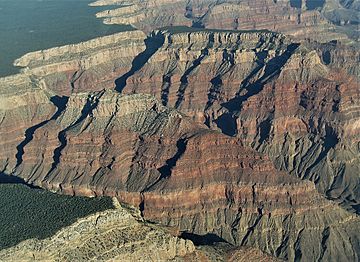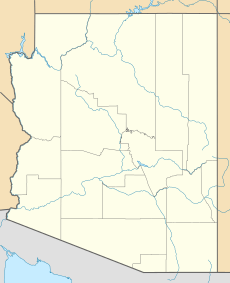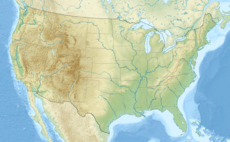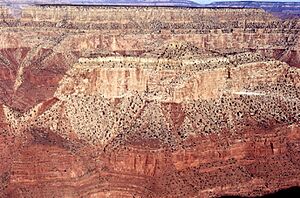Vesta Temple facts for kids
Quick facts for kids Vesta Temple |
|
|---|---|

Aerial view, Vesta Temple left, Diana (right)
|
|
| Highest point | |
| Elevation | 6,299 ft (1,920 m) |
| Prominence | 889 ft (271 m) |
| Isolation | 1.27 mi (2.04 km) |
| Parent peak | Diana Temple (6,683 ft) |
| Geography | |
| Location | Grand Canyon National Park Coconino County, Arizona, US |
| Parent range | Coconino Plateau Colorado Plateau |
| Topo map | USGS Piute Point |
| Type of rock | limestone, sandstone, mudstone |
| Climbing | |
| First ascent | Alan Doty |
Vesta Temple is a tall peak, or summit, in the amazing Grand Canyon in Arizona, USA. It stands 6,299 feet (about 1,920 meters) high. This impressive landform is located in Coconino County, which is in northern Arizona.
Vesta Temple is about eight miles west-northwest of Grand Canyon Village. It's also very close to Mimbreno Point. Other nearby peaks include Marsh Butte and Eremita Mesa. Its closest taller neighbor is Diana Temple, which is about one mile north. Vesta Temple rises an incredible 3,900 feet (1,190 meters) above the Colorado River in just 2.5 miles!
This peak is named after Vesta, who was the Roman goddess of the hearth, home, and family. Long ago, a person named Clarence Dutton started the tradition of naming Grand Canyon features after gods and goddesses from myths. The name "Vesta Temple" was officially chosen in 1908 by the U.S. Board on Geographic Names. The area around Vesta Temple has a Cold semi-arid climate, which means it's usually dry and can have cold winters.
What Vesta Temple is Made Of
The very top of Vesta Temple is made of two types of rock: Permian Kaibab Limestone and Toroweap Formation. These layers sit on top of a cream-colored rock called Coconino Sandstone. This sandstone forms tall cliffs.
How the Rocks Formed
The Coconino Sandstone is one of the younger rock layers in the Grand Canyon. It formed about 265 million years ago from ancient sand dunes. Below this sandstone, you'll find reddish, sloped rock called Hermit Formation. Underneath that is the Pennsylvanian-Permian Supai Group.
Even further down, there's a noticeable cliff-forming rock called Mississippian Redwall Limestone. Below that are layers from the Cambrian Tonto Group. Finally, at the very bottom, near the Colorado River in Granite Gorge, you can see granite from the Paleoproterozoic Vishnu Basement Rocks.
Water Flow from Vesta Temple
Rainwater and snowmelt that run off Vesta Temple flow northeast. This water eventually reaches the Colorado River by traveling through Topaz Canyon and Boucher Creek.




